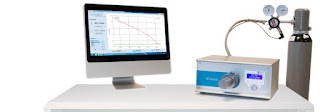Measurements at cryogenic temperatures were never this easy!
We recently launched a new line of plug-n-play desktop cryocoolers for applications requiring cooling of small samples to 90 K or further down to 75 K (i.e. SQUIDs).
We recently launched a new line of plug-n-play desktop cryocoolers for applications requiring cooling of small samples to 90 K or further down to 75 K (i.e. SQUIDs).
Known as CryoLab, by Kryoz Technologies of Holland, the LN2-free low-temperature analysis cooling systems allow for characterisation measurements from room temperature down to cryogenics in a fully automated manner. Doing measurements doesn’t require any experience or know-how on cryogenics, vacuum technology or thermodynamics from the user.
The major application fields addressed are:
Solar Cells
Using The CryoLab, it is possible to characterise solar cells at cryogenic temperatures.
Thin films
Using The CryoLab, it is possible to perform various characterization measurements on thin film samples.
Heat capacity
The heat capacity of most systems is not a constant. Rather, it depends on the state variables of the thermodynamic system under study. In particular it is dependent on temperature itself.
SQUID sensors
A SQUID is a very sensitive magnetometer made using superconducting materials. Using Kryoz hardware is it possible to cool these samples below their characteristic critical temperature.
Xray sensors
Xray sensors can detect xray radiation. Cryocooling the sensor improves signal-to-noise ratio, highly increasing its sensitivity.
Infrared sensors
IR sensors can detect infrared radiation. Cryocooling the sensor improves signal-to-noise ratio, highly increasing its sensitivity.
Seebeck measurement
The Seebeck effect is the direct conversion of temperature differences to electric voltage and vice versa. With Kryoz hardware it is possible to measure the Seebeck effect at cryogenic temperatures.
Electron microcopes
Cryocool samples in an EM beam. Zero vibration cryocooling in combination with extreme small size.
High Tc Bolometers
A bolometer is a device for measuring the power of incident electromagnetic radiation via the heating of a material with a temperature-dependent electrical resistance.
UV sensors
UV sensors can detect ultraviolet light. Cryocooling the sensor improves signal-to-noise ratio, highly increasing its sensitivity.
Low-noise amplifier
A low-noise amplifier (LNA) can amplify extremely weak signals. Cryocooling the LNA improves signal-to-noise ratio, highly increasing its sensitivity.
Beamline Science Custom Designs
In accelerator physics, beamline refers to the particle trajectory along a specific path of an accelerator facility. Beamlines usually end in experimental stations that utilize particle beams or synchrotron light, or neutrons from a spallation source or research reactor. If you need to cool a sample within the beamline, it can get complicated. Since in practice there often are no off-the-shelf cryogenic solutions for beamlines, a product development work-flow concept proven to be reliable is used and results in a very high chance of success.
